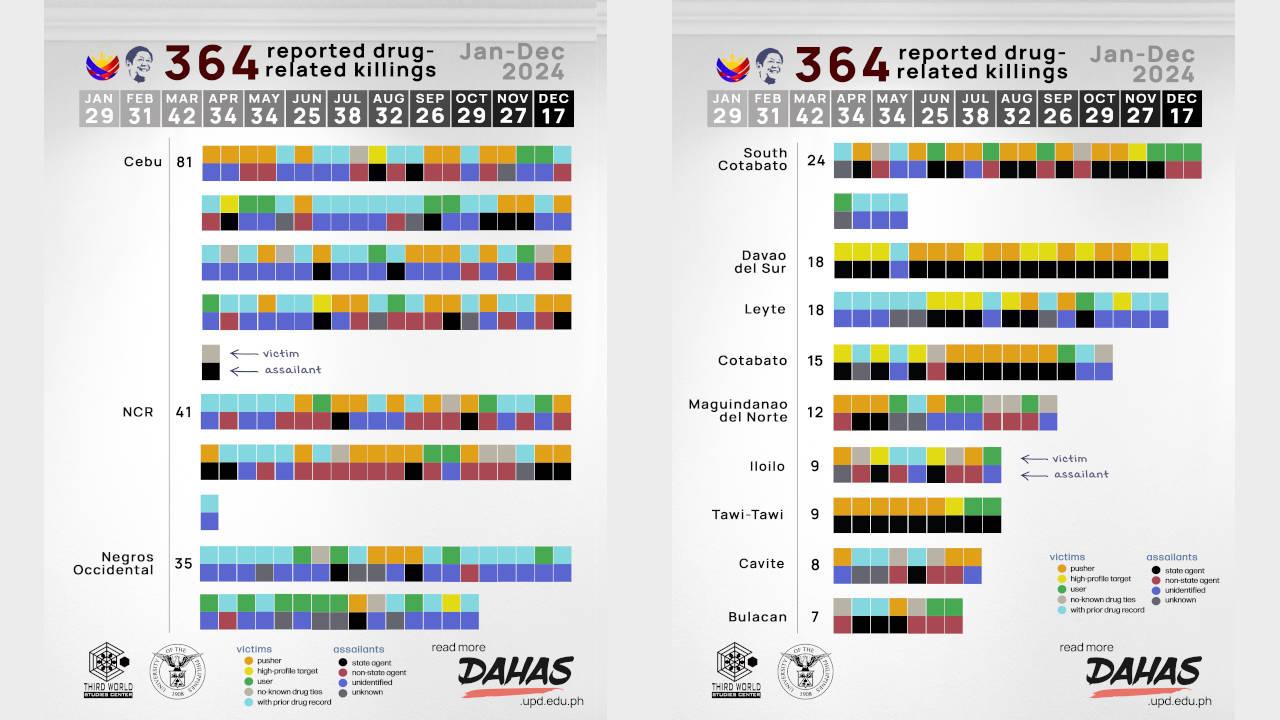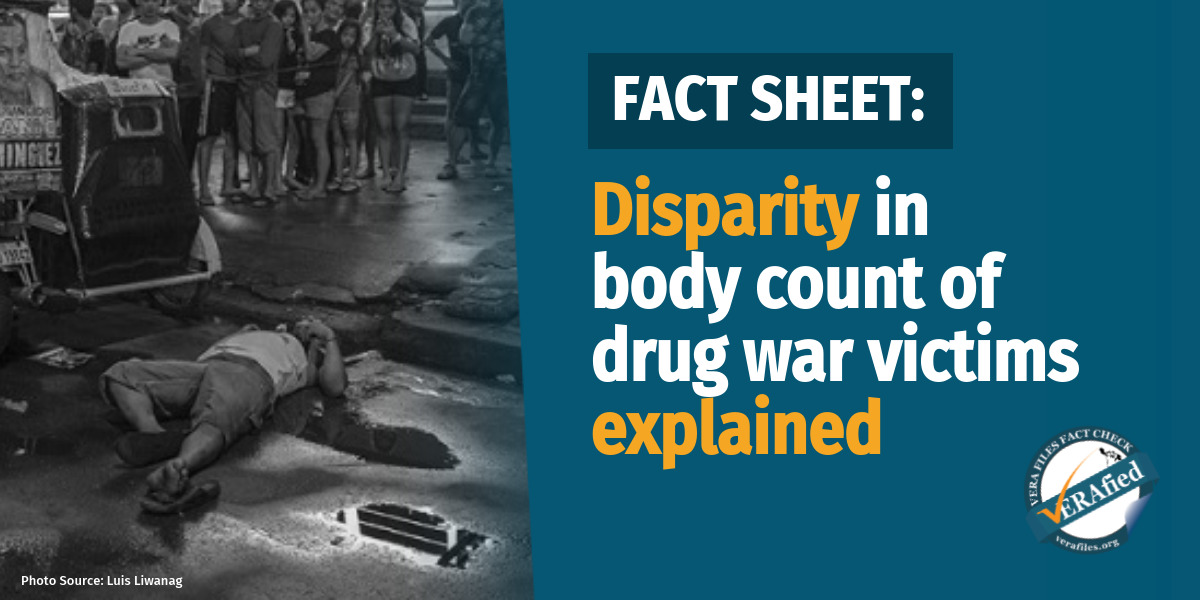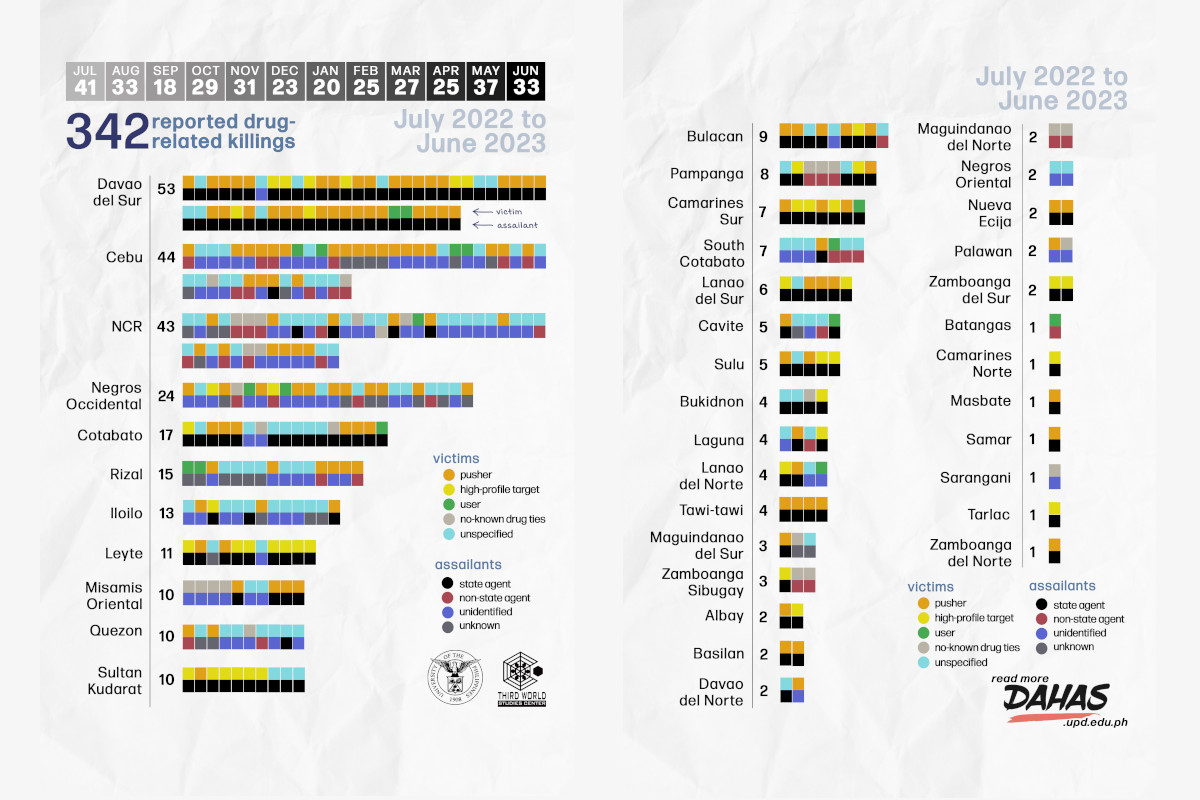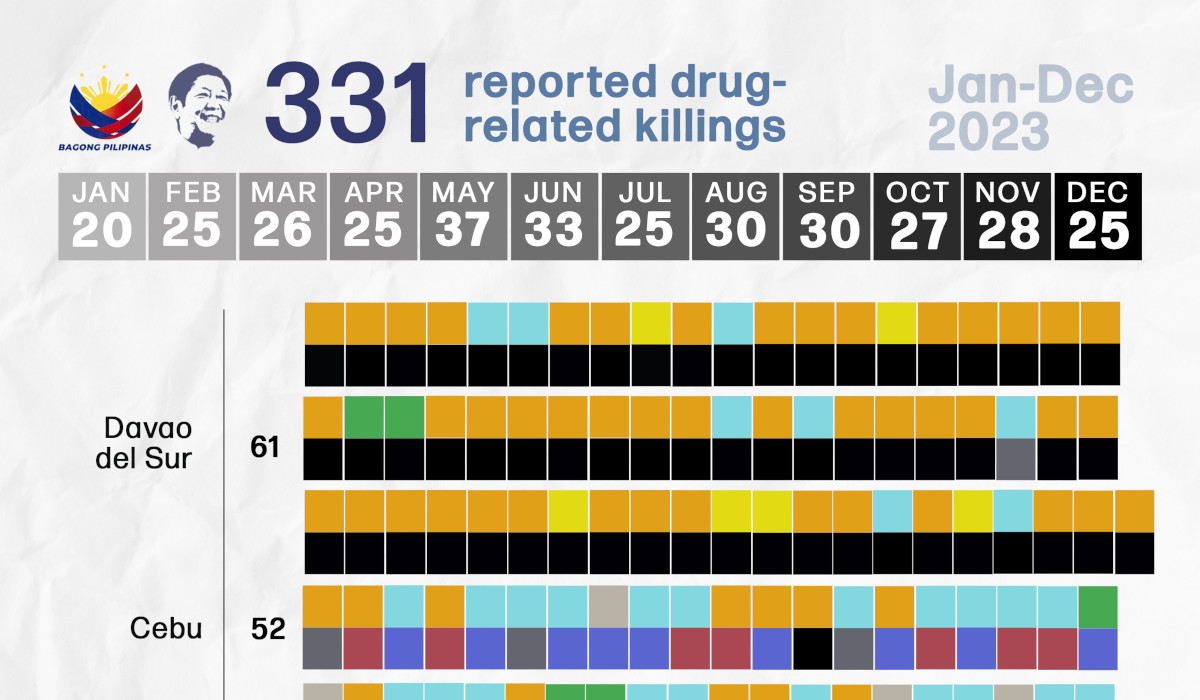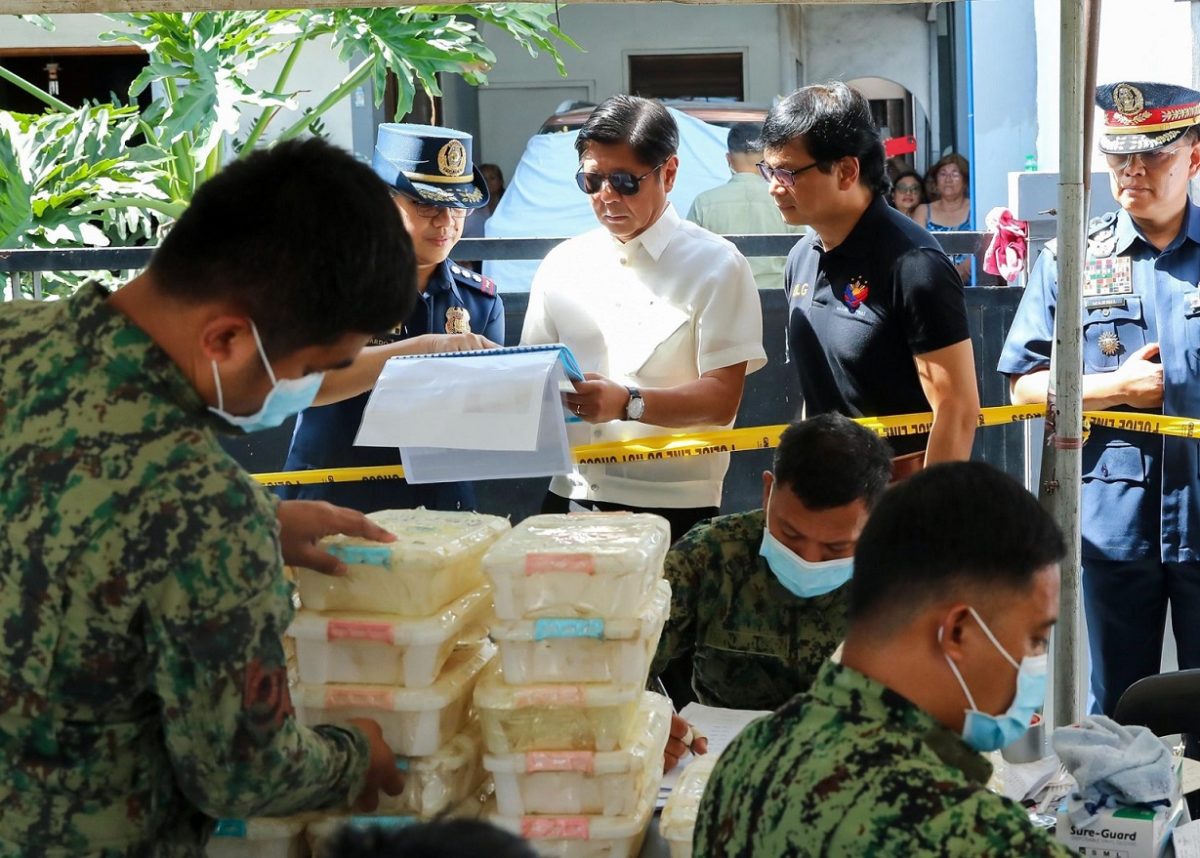The Dahas Project of the UP Third World Studies Center logged more reported drug-related killings in 2024 than in 2023—from 331 to 364, a 10 percent increase.
Of the killings, 142 or 39.01 percent were committed by unidentified assailants. This is followed by the killings perpetrated by state agents (112 or 30.77 percent), mainly the police and to a lesser extent members of the Philippine Drug Enforcement Agency (PDEA). Since the Dahas Project started its weekly online monitoring in 2021, this is the first time that more killings were attributed to unidentified assailants than to state agents.
Of those killed, 125 or 34.34 percent were identified in the news accounts to have had prior drug records. Those identified as pushers were in close second with 120 or 32.97 percent of the victims. This is a slight reversal of the trend since 2021 when pushers outnumber all other victim categories. Another significant change from previous years’ trend is the number and percentage of users killed. Since 2021 until 2023, those reported as users have not exceeded 7 percent of those killed; in 2024 they account for 16.21 percent.
Similar to 2023, the majority of the victims were male, comprising 328 or 90.11 percent of the killings. On the other hand, only 33 or 9.07 percent were female, while reports do not mention the sex of 3 or 0.82 percent of the victims.
In terms of age group, the same trend continues from 2023. Victims aged 30-39 years old still account for the largest part of the killings with 89 or 24.45 percent, followed by 20-29 year olds at 60 or 16.48 percent, 40-49 year olds at 58 or 15.93 percent, 50-59 year olds at 14 or 3.85 percent, 13-19 year olds at 7 or 1.92 percent, and 60-69 year olds at 5 or 1.37 percent.
In Cebu, Kenjie De Jesus was murdered two days before his 14th birthday. Police identified him as a drug pusher due to the 13 sachets of shabu found on his corpse. According to his mother, Kenjie may have been taken advantage of by a drug syndicate.
While 2023 did not have any victims under the age of 13, one child aged 6 years old was killed in 2024. He and his 43-year-old mother were bludgeoned to death, allegedly by a “friend” of his father who is currently imprisoned for drug-related crimes.
The rest of the victims’ ages were not disclosed in their respective news reports.
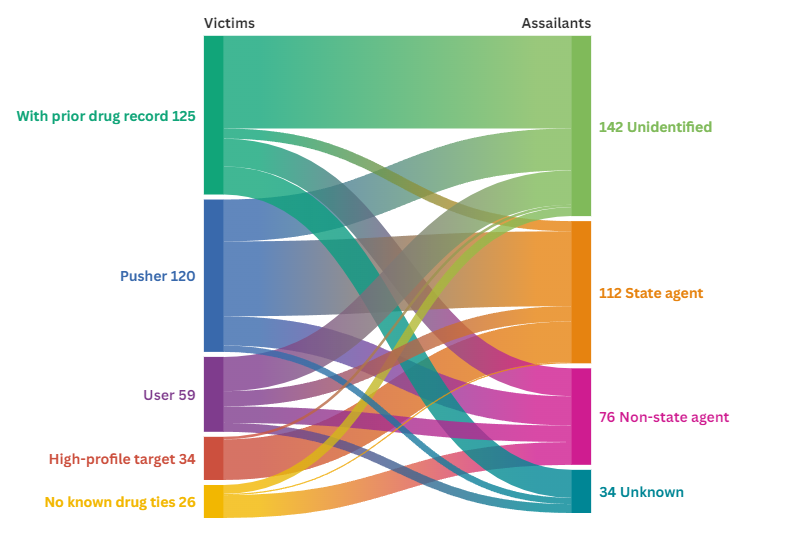
With 364 deaths, almost one killing a day, 2024 was a record year for Marcos Jr.’s administration in reported drug-related killings. If, however, there is any change that can be attributed to the government, it is in the involvement of state agents in the killings.
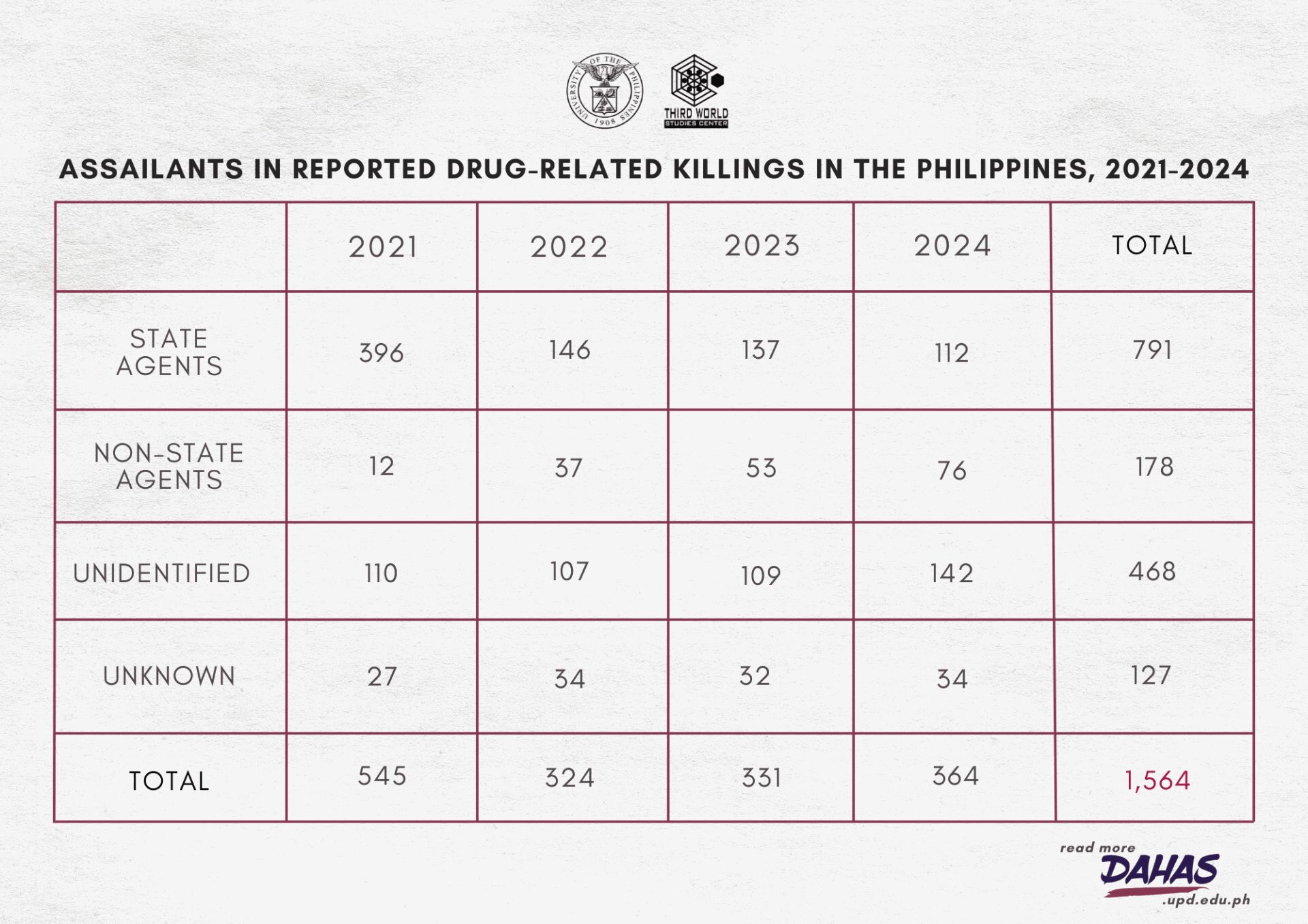
This year saw a significant decrease in deaths committed by state agents. From 41.39 percent in 2023, their share dropped to 30.77 percent in 2024. This could be reflective of the supposed ever new direction in combating illegal drugs that the Marcos Jr. administration has been touting since it began.
But given the continued increase in reported drug-related killings, this means that there was an increase in killings committed by the different kinds of assailants as compared to last year. Deaths at the hands of non-state agents (these were murderers named by witnesses and identified not to state agents) increased from 16.01 to 20.88 percent and unidentified assailants from 32.93 to 39.01 percent. Meanwhile, victims of unknown assailants (mainly cases of body dumps and killings without any witnesses) were reduced slightly from 9.67 to 9.34 percent.
Unidentified assailants killed 142: 73 with prior drug records, 33 pushers, 27 users, 7 with no known drug ties, and 2 high-profile targets. State agents killed 112: 59 pushers, 32 high-profile targets, 12 users, 8 with prior drug records, and 1 with no known drug ties. Non-state agents killed 76: 23 pushers, 22 with prior drug records, 13 users, and 18 with no known drug ties. Unknown assailants killed 34: 22 with prior drug records, 7 users, and 5 pushers.
The killing of high-profile targets—those involved in large-scale distribution, members, or leaders of drug crime groups—used to be the preserve of state agents. But 2024 saw the killings of Ivan Gonzales of Ormoc City and Edgar Cara-at of Escalante City, both tagged as high-profile targets, at the hands of unidentified assailants. This could be indicative of a spark of boldness on the part of those engaged in the drug trade to resolve conflicts within their ranks in however murderous a way they prefer. For the longest time, the government has been wont to say that its drug war efforts are focused on eliminating high-profile targets—drug lords and the like. In this regard, it seems to be getting help from its competition.
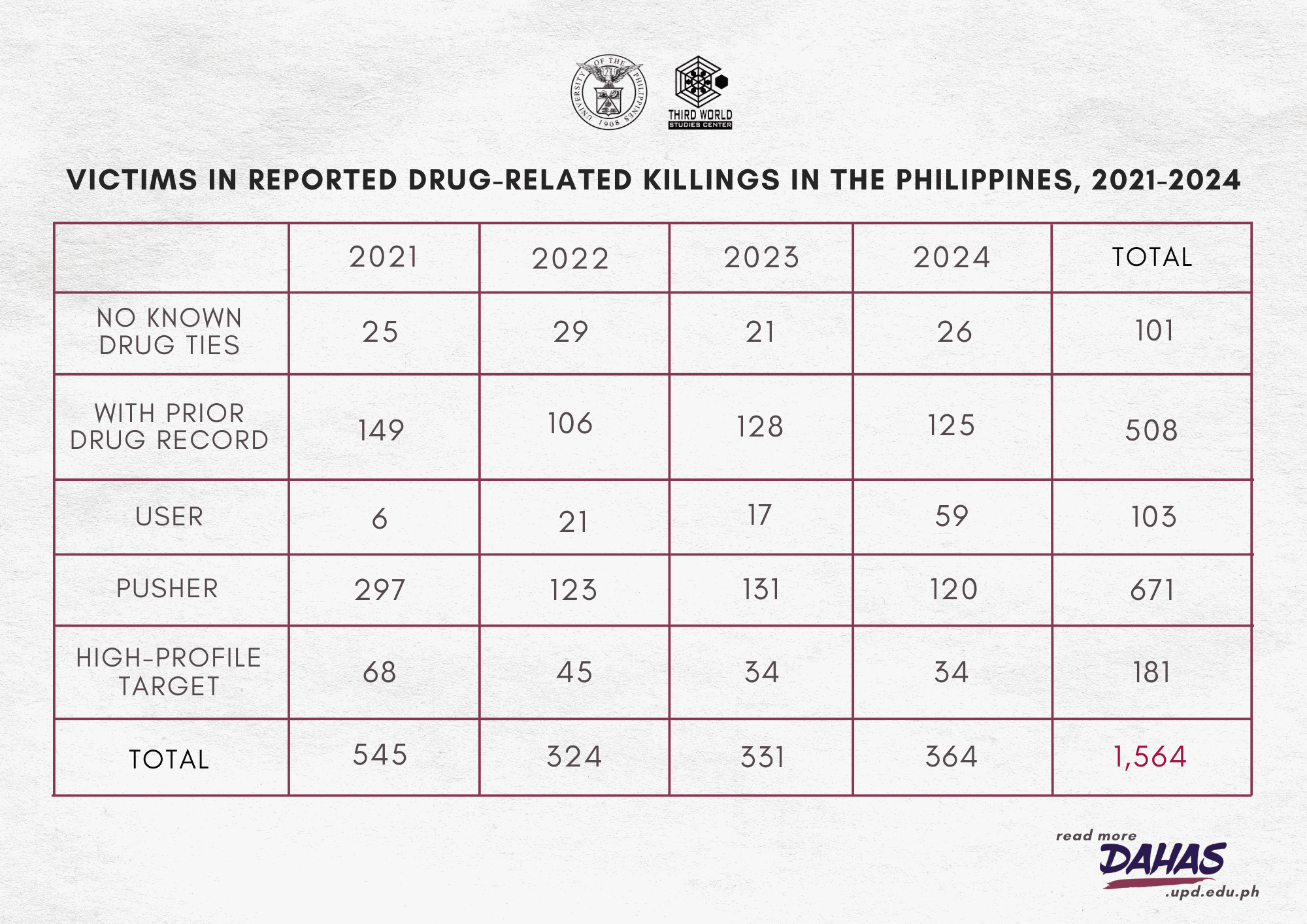
The 2024 data on the victims of reported drug-related killings also continue to belie the supposed focus of the government on neutralizing high-profile targets. In an almost 2:1 ratio, the police and the PDEA have killed more street-level pushers than high-profile targets.
Most of the victims of reported drug-related killings in 2024 were pushers and those with prior drug records (these are individuals who have served time due to drug charges, still with pending cases, and those in the drug watchlists devised by the government). Dahas recorded two cases—Jemar Pepino Cañete, a 22-year-old in Cebu and an unnamed 24-year-old in Malabon—wherein the victims were killed within one week or even just days upon gaining their freedom.
The victims in these combined categories account for 245 or 67.3 percent of all the victims. Almost half of them (106 or 43.2 percent) were killed by unidentified assailants, 67 by state agents, 45 by non-state agents, and 27 by unknown assailants.
There is also a spike in drug users getting killed. In 2023, there were 17 of them killed; in 2024, 59, a 247 percent increase. Most of them were killed by unidentified assailants.
These numbers point to a thriving traffic in drugs and violence that either the government has conveniently neglected (let them kill each other) or has miserably failed to police—or both.
Not that the government side had not known losses again this year in its war on drugs.
In 2024, 26 victims or 7.14 percent had no known drug ties. This category used to include those identified as “collateral damage,” unintended fatalities in the drug war, but Dahas has also used this category to include state agents who were killed during anti-narcotics operations or those who were killed because of their anti-illegal drugs work.
This year, 7 state agents were killed, one a member of PDEA while the rest were police officers. All were on active duty at the time of their deaths—either buy-bust or surveillance operations—except for M/Sgt. John Manuel Bongcawil, who was gunned down by unidentified assailants as he was leaving the City Mall of Cotabato with his family. It has been suggested by his colleagues that his death was due to his involvement in several anti-drug operations.
During a peace and order operation on New Year’s Eve, Senior M/Sgt. Ryan Mariano was in a shootout with two high-profile individuals involved in drug trafficking among other crimes. A member of Zamboanga City’s Special Drug Enforcement Team, Mariano survived a gunshot to the stomach while the two suspects identified as Haber Tating and Kashmir Ladjahassan Jallao were killed.
This category also includes police assets, informants, previous witnesses to drug cases, and victims of mistaken identity. Confined inside a hospital in Dasmariñas, Cavite, Chatty Timbang was sleeping when she was shot dead by three armed men. Lt. Col. Julius Balano attributed her death to her previously providing information on drug-related activities in the area. Her mother, sleeping by her bedside, was also shot in the thigh but survived. One of the suspects admitted that the crime was an “extra judicial confession.”
In February, police brought their asset Bernard “Nikki” De Guzman to a buy-bust operation in Bulacan. The target, alleged drug pusher alias “Alexis,” shot him dead. Police immediately gunned down Alexis. There were no reported casualties at the police end.
Simply being mistaken for a police asset could also get you killed, as in the case of Mylene Gomalao of Cebu. Seven other informants were killed in 2024.
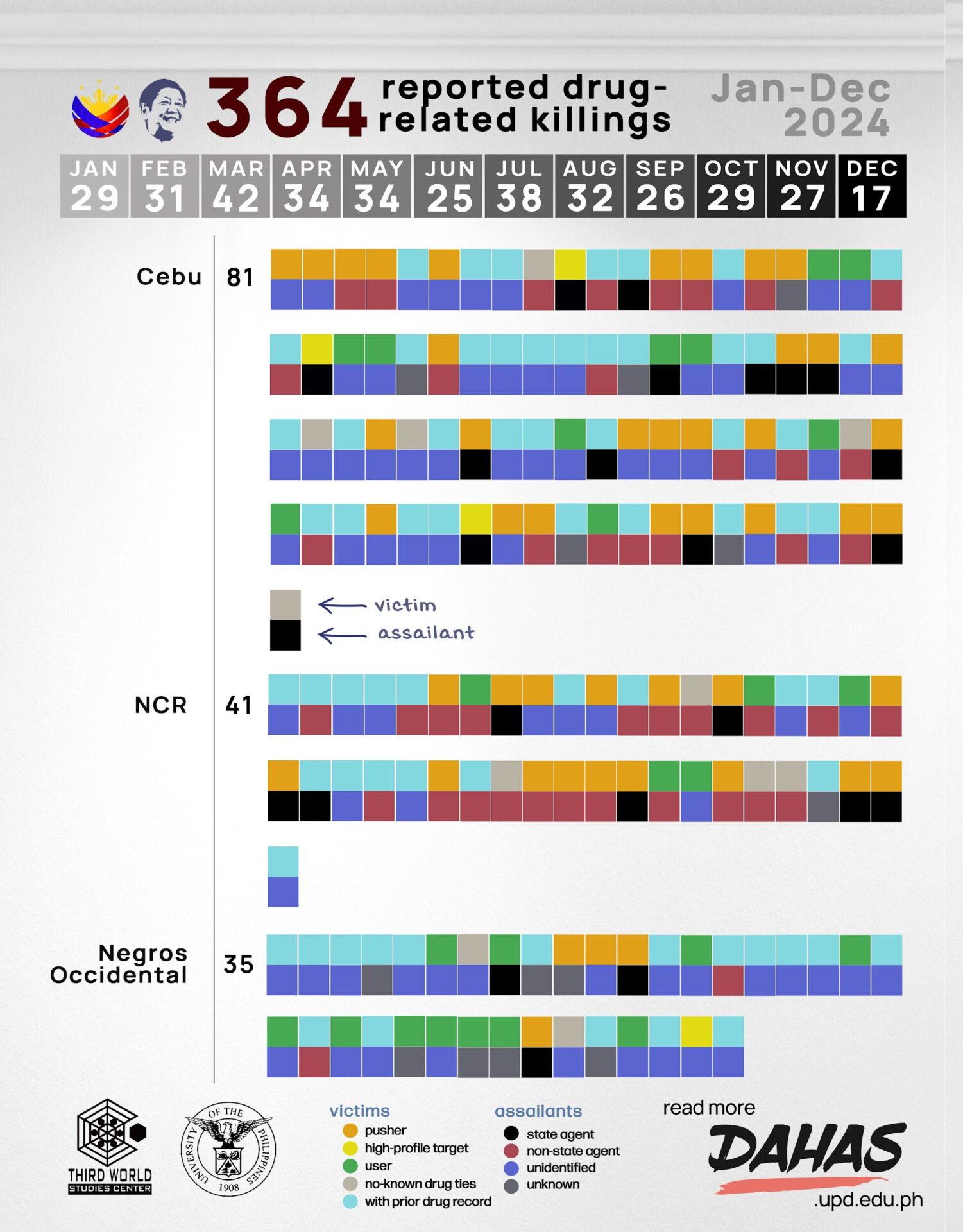
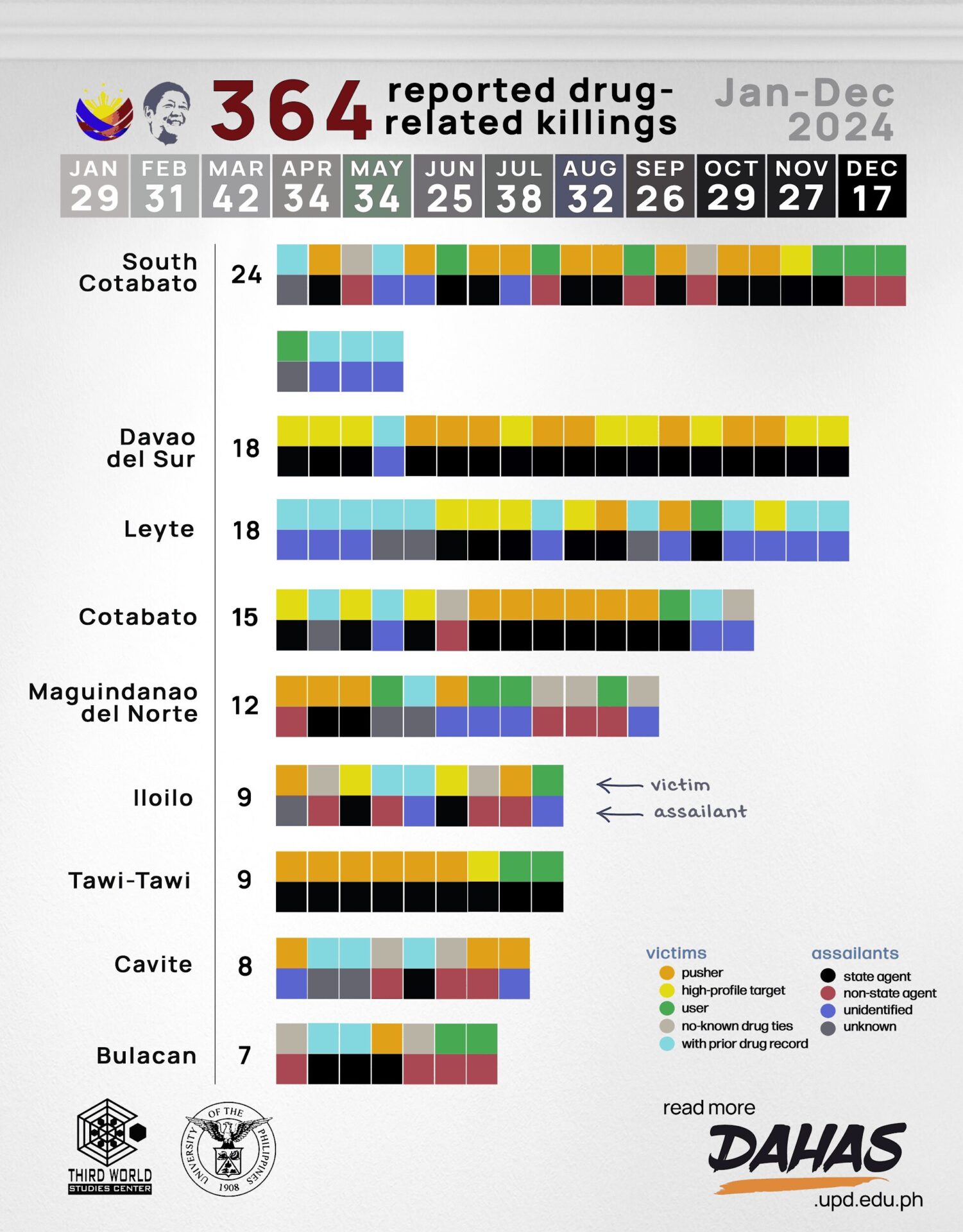
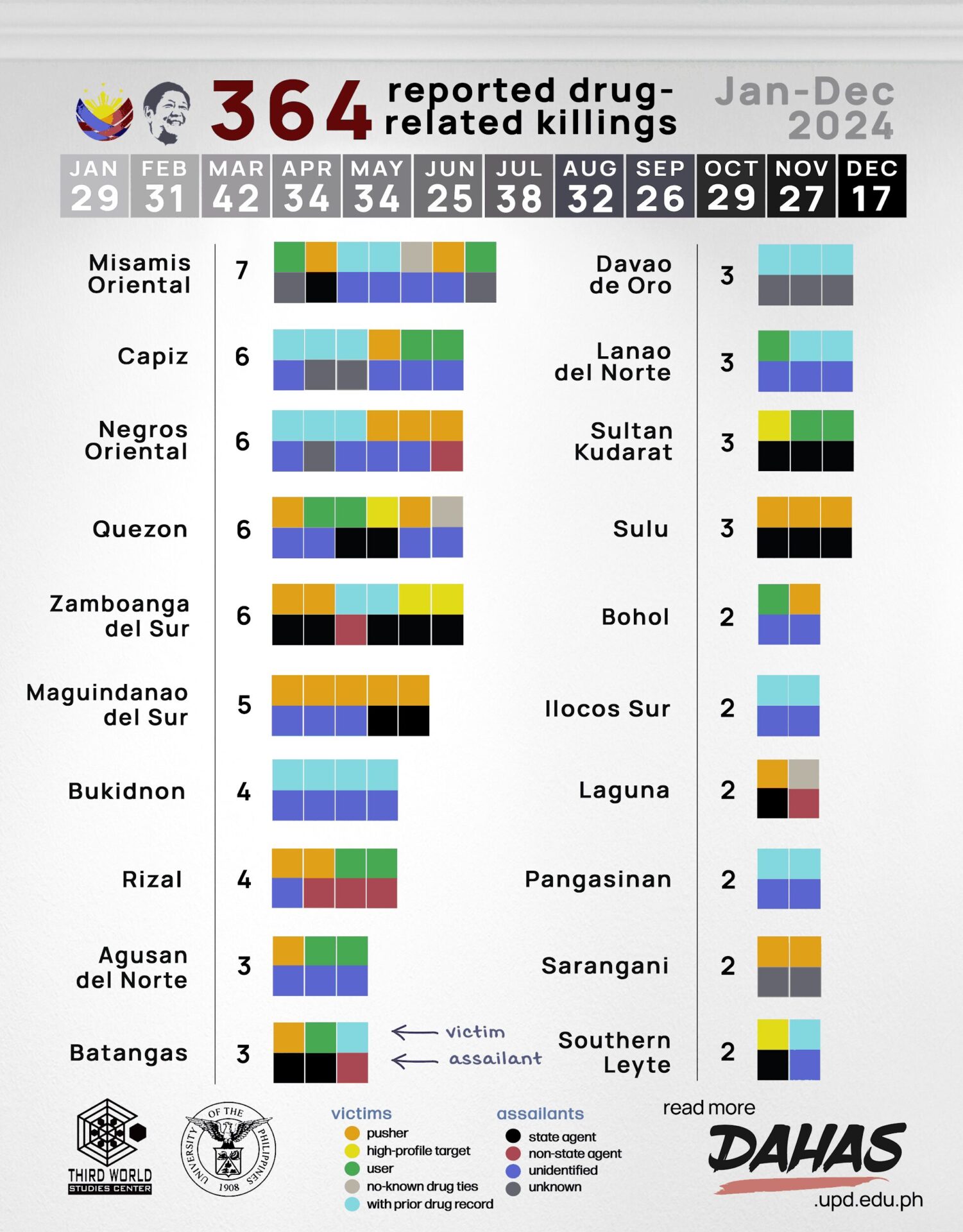
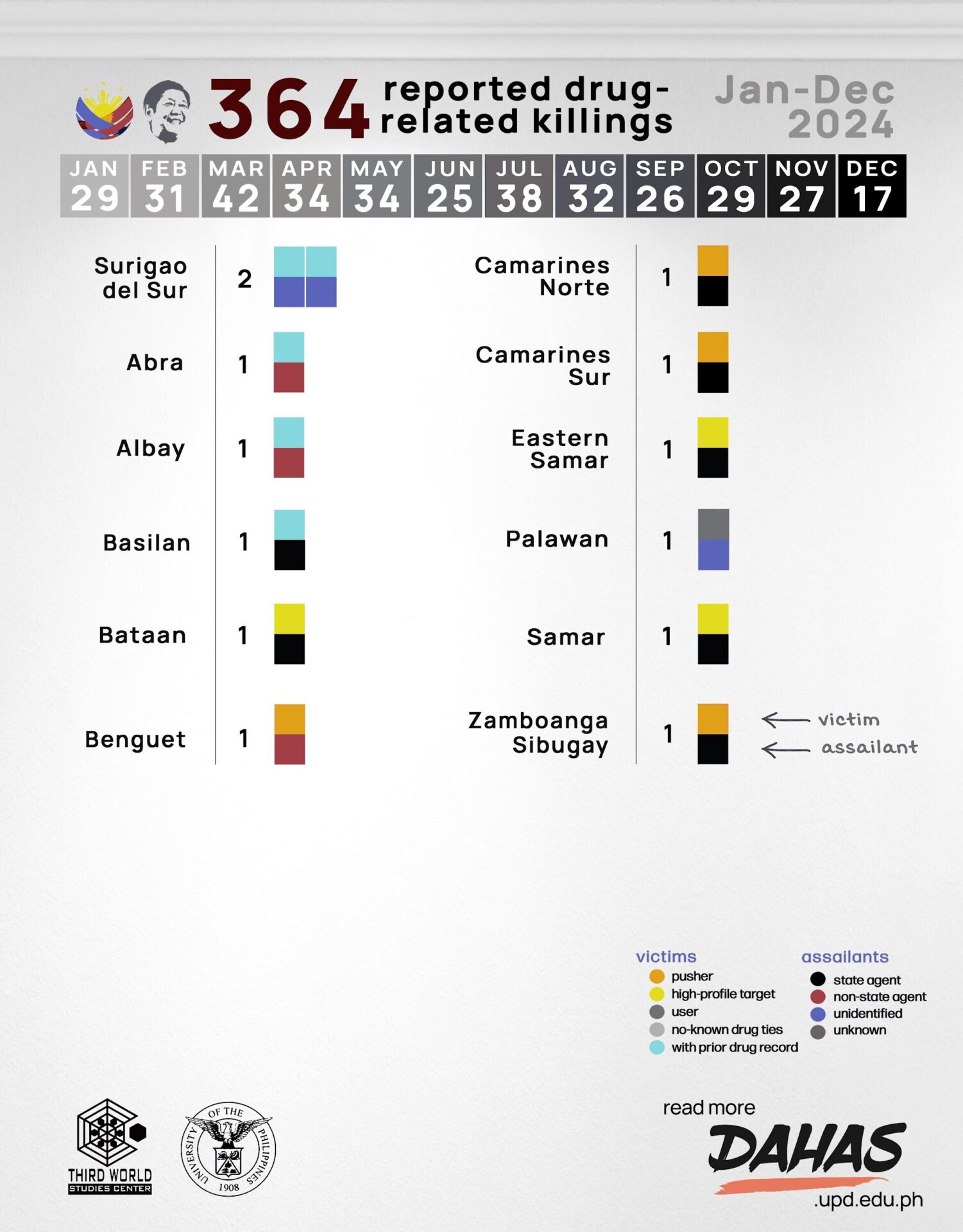
In 2024, eight provinces registered double-digit killings: Cebu, 81; NCR 41; Negros Occidental, 35; South Cotabato, 24; Davao del Sur, 18; Leyte, 18; Cotabato, 15; and Maguindanao del Norte, 12.
Cebu, with 81 killings, is the top hotspot in the country for reported drug-related killings. It pushed Davao del Sur, the past two years’ topnotcher, to fifth place with 18 killings. Cebu accounts for more than one in every five (22 percent) of the reported killings at a rate of almost two (1.56) killings every week. More than in any other province in the country, it is in Cebu that employment of gun-for-hires or hitmen is most prevalent. Of the 81 killings recorded in the province, only 14 resulted from police operations, while the rest were perpetrated by vigilantes or identified private individuals. Half of the time, assailants were unidentified, while a quarter of the total killings were executed by non-state agents.
In the Duterte bailiwick Davao City, indeed in the entire Davao del Sur, only one death was recorded after March 27. Cebu beating Davao, previously a well-known hot spot for drug-related killings, may be attributed to the shifting political fortunes of the Dutertes.
Last March, the leadership of Philippine National Police (PNP) started to replace the head of Davao city police several times over and relieve Davao cops suspected of being involved in the drug-related killings. These movements occurred after Davao City mayor Sebastian Duterte, son of former Philippine president Rodrigo Duterte, declared his own drug war in the city. Despite the lull, however, Davao del Sur still had the most killings by state agents (17 out of 18) in 2024.
On November 19, 2024, the Police Regional Office 7 (PRO 7) in Central Visayas issued a statement challenging the SunStar Cebu report, “Study: Cebu leads in drug war killings.” The report was based on findings by the Dahas Project, as featured in a Vera Files article. PRO 7 called the Dahas data “inaccurate” and “not reflective of the true situation on the ground, especially in Cebu.”
PRO 7 reported 12 drug-related deaths in Cebu from January to October 15, 2024, attributing them to drug traffickers. Dahas documented 68, 11 of which involved police operations. In the Dahas report, it was emphasized that its data comes from journalists who directly cover drug-related killings in various barangays across Cebu. Often, the published news reports cite police statements. PRO 7 failed to consider in their response the drug-related killings that they themselves committed. This makes their response a self-serving denial rather than a well-intentioned clarification.
After ringing in the new year, reported drug-related killings in Cebu remained unabated. In the first week of January 2025, Cebu already had four killings.
Before 2024 ended, the PNP professed a vow to keep their momentum. They are in a momentum, they say, of enhancing their strategies to combat illegal drugs and ensuring a safer and a more secure Philippines for all. Compared to 2023 figures, PNP reported an increase in seized illegal narcotics last year, totalling PHP 20.7 billion worth of drugs. The report, however, missed a similar momentum: an increase in drug-related killings in the country during the same period.
(Joel F. Ariate Jr., Aidrielle Raymundo, and Vincent Halog are the researchers in charge of the Dahas Project of the Third World Studies Center of the College of Social Sciences and Philosophy, University of the Philippines Diliman. Follow on X (formerly Twitter) the most recent Dahas reports: https://twitter.com/DahasPH.)
